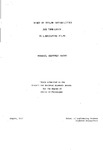STUDY OF TAYLOR INSTABILITIES AND TURBULENCE IN LUBRICATING FILMS
| dc.contributor.author | SHORT, MICHAEL GEOFFREY | |
| dc.contributor.other | School of Engineering, Computing and Mathematics | en_US |
| dc.date.accessioned | 2013-11-04T13:24:33Z | |
| dc.date.available | 2013-11-04T13:24:33Z | |
| dc.date.issued | 1977 | |
| dc.identifier | NOT AVAILABLE | en_US |
| dc.identifier.uri | http://hdl.handle.net/10026.1/2577 | |
| dc.description.abstract |
The development of the wavy mode of Taylor vortices in the flow between a rotating inner cylinder and a stationary outer cylinder has been investigated by visual observations using a stroboscopic technique and by inner cylinder torque measurements. Radius ratios of 0.874, 0.911, 0.950 and 0.975 have been tested for the concentric and eccentric cylinder cases. The stability of wavy mode flow has been found to decrease with increasing radius ratio and/or increasing eccentricity. Observations of the flow suggested that the wavy mode can be classified into three regimes called, respectively, the primary, transitional and secondary modes. The three regimes were most easily identified using a radius ratio of 0.911 and concentric cylinders. In this case, the onset of the transitional state (so called because of the tendency for the circumferential wave number to change continually even at particular constant speeds) was found to be particularly violent, completely destroying the well defined nature of the primary wavy mode. Rather surprisingly, this quasi-turbulent regime of wavy mode flow was found to give way to the more regular secondary wavy mode as the speed of the inner cylinder was increased. Non-uniqueness is shown to be an important feature of wavy mode flow. Results are presented showing that circumferential wave number changes can often be detected by torque measurements. In particular, the onset of the transitional state results in a sudden reduction in the required driving torque, the magnitude of which is considerably influenced by the stability of the primary wavy mode flow. Friction coefficient characteristics derived from the torque measurement results are used to deduce a general relationship incorporating the effects of the eccentricity and radius ratios. | en_US |
| dc.language.iso | en | en_US |
| dc.publisher | University of Plymouth | en_US |
| dc.title | STUDY OF TAYLOR INSTABILITIES AND TURBULENCE IN LUBRICATING FILMS | en_US |
| dc.type | Thesis | en_US |
| plymouth.version | Full version: final and full version as approved by the examiners at the time of the award of your degree | en_US |
| dc.identifier.doi | http://dx.doi.org/10.24382/1415 | |
| dc.identifier.doi | http://dx.doi.org/10.24382/1415 |
Files in this item
This item appears in the following Collection(s)
-
01 Research Theses Main Collection
Research Theses Main


